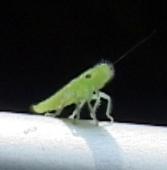
colors and sizes. The trout will
eat them if they fall into the
water.
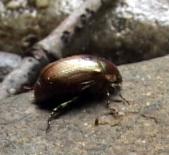
all colors and sizes. Heavy
rain can wash them in the
water.
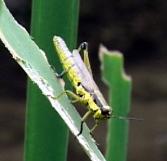
blown into the water in high
winds. This is a good time to
fish the imitations.
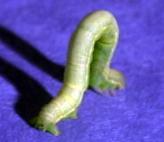
and plentiful in the park. If they
fall into the water, the trout will
eat them.
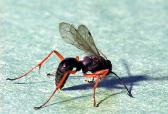
terrestrial insect in the park
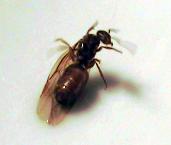
in the park. When they do show
up, be prepared for them.
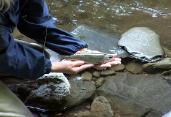
the summertime diet of all
species of trout in the park.
Introduction To Terrestrial Insects:
Terrestrial insects are insects that are born and spend most of their life on land. They get into the water only by accident. Windy conditions and other natural conditions can cause these insects to sometimes loose their caution and end up becoming a meal for a trout.
It would be a rare occasion that trout ever became selective on any terrestrial insect in the Great Smoky Mountains National Park. It would be possible during a flying ant fall, or possibly when a large amount of ants or beetles were washed into the water by heavy rains or high winds. This means that most all of the time, the trout are just looking for something to eat on the surface of the water. They do not recognize the various types or species of terrestrial insects that may come floating by. The strictly feed opportunistically on them. When there are few insects on the water trout are likely to take every insect that comes by.
If a large amount of any one insect became available over a period of time, then it would be likely that the trout would search only for that insect or feed selectively on it. When this happens, they begin to settle into a steady feeding rhythm and focus on individual insects. Facts are, it would be rare that enough terrestrial insects fell, blew or got washed into the water to cause selective feeding. We have never seen it happen in the park.
Imitations of Terrestrials: (Flies)
This means that you can get by with, except for a few rare exceptions, fishing an imitation of any terrestrial insect you desire to imitate. As long as it is something of the size and shape of an insect, the fish will see your fly as something to eat. Their brain is not large enough for them to be able to identify it as something they saw last year at the particular time of the year. They they don’t need to be able to do so in order to survive. They may eat a beetle one minute and a grass hopper a few minutes later.
If the fly sinks, it will probably get more takes from trout than if it floats beautifully on the surface. Most ants, beetles and hoppers that fall into the water slowly sink. These are some of the more plentiful and common terrestrial insects that get into the freestone streams of the Great Smoky Mountain National Park.
Beetles:
The most common terrestrial insect in the park is the beetle or Coleoptera. There are both aquatic and terrestrial forms of beetles but here we are concerned with the terrestrial form. June bugs, lady bugs, bark beetles, ground beetles are some of the types of beetles found in the park. Some species of beetles can fly and these are more likely to get into the water than the others that cannot fly. Overhanging limbs of trees, grass and shrubs provide the places for beetles to fall into the water.
Ants:
Ants, the Formicidae family of insects, are probably the next most plentiful terrestrial insect found in the park. Fast rising water caused by heavy rains is responsible for ants and terrestrial beetles getting into the water more than anything else. Ants live in colonies and when they do get washed into the water, they usually do so in large quantities.
Some ants can fly and these flying ants can easily wind up in the water. When they do, they are usually preyed on by trout in a feeding frenzy. These great swarms of arts perform their nuptial flights, the winged males or drones die shortly after they swarm. If the flight of ants happens over a stream they fall in the water and usually just carpet the water. Don’t stand around waiting for this to happen, you may grow old waiting. But if you find flying ants falling in the water, the trout will usually go nuts. Be prepared for a flying ant fall. They usually occur during the summer months.
Grasshoppers:
Grasshopper exist on every stream in the park but they are not as plentiful in the forest as they are in the streams that flow through fields and open areas where high grass exist. There are many areas where streams flow along open fields and meadows.
Where ever you find banks with lots of grass there most likely are lots of grasshoppers. Grasshoppers become important starting in June but much more so in the latter part of the summer and early autumn. They are apt to get into the water much more so on windy days. If the wind is blowing strong, and it’s during the Summer and early Fall months, you should give a hopper imitation a try. Be aware that strong wind in the forest can be dangerous. Use caution and don’t fish when it’s too windy.
Crickets:
Crickets are quite plentiful in the forest of the Smokies. You may never see them in large quantities but they exist almost everywhere. Some anglers consider the cricket to be more important than the grasshopper. Actually, the trout probably do not see enough of them to recognize the difference and will probably make no distinction between the two.
Inch worms/loopers:
Inchworms and loopers of the Geometridae family, are the larvae stage of moths. They feed on leaves but when they are grown they descend to the ground on a silk thread to pupate. They don’t seem to know or maybe have no choice in selecting where they land, on water or land. When they land on the water, they usually just hang there bouncing in the current until the thread breaks. Trout feed on them aggressively. You can fish an imitation, usually green or brown, on the surface or using a drag-free drift below the surface. They are usually most available during the summer months but since there are thousands of species (nationwide-we are not sure about the park) they are probably available to trout during a much longer period of time.
Bees and Wasp:
Bees live in colonies. These colonies are usually very large and contains thousands of insects. One of the common ones in the park is the yellow jacket.
Copyright 2011 James Marsh

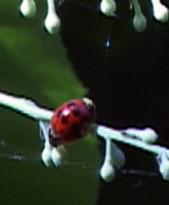
These are very plentiful in the
park. How many of them gets
into the water is another
question.
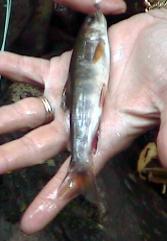
imitations of terrestrial insects
as large as their mouths.
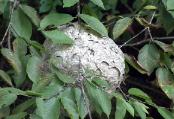
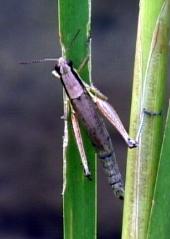
hangs right beside the water

an inch.

strike indicator on its back.
